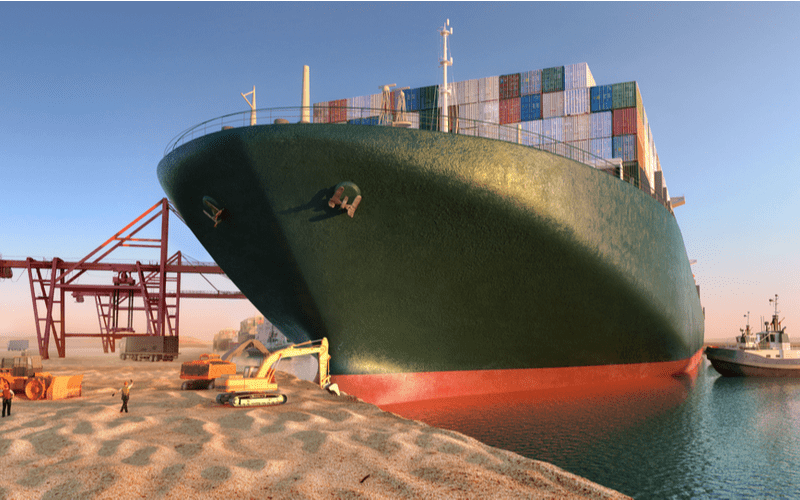In what feels like an anti-climactic end to an incredible story, the Ever Given – the boat that broke the internet when it blocked the Suez Canal back in March – has finally docked at Felixstowe, England, with its cargo from the Far East – a full four months after it was scheduled to arrive.
It was one of those great black swan events that kept many of us enthralled for days, but what can this whole event teach us about supply chain resilience? Billions of pixels of digital news have been used to describe how supply chains need to understand the macro picture, like shipping delays and supply impacts. Today, I want to focus on the micro. I want to follow the ripples of the Suez Canal situation all the way to the UK high street.
In an earlier blog, I wrote about volatile customer demand and how a modern machine learning forecasting algorithm needs to account for uncertainty. To re-cap, the Blue Yonder demand forecasting service looks for relationships between influencing factors, such as weather, price, and season, rather than attempting to layer on top of a demand forecast based on historical sales. That is the key to understanding uncertainty and driving better forecast accuracy. Now that the Ever Given’s cargo has finally landed in the UK, there is a lot of uncertainty about to disembark.
Uncertain Supply
The Ever Given holds around 18,000 shipping containers containing a mix of perishables and non-perishables. The perishables will be destroyed, but many of the non-perishables will have been timed for start of spring. Some may go directly into UK market via discount retailers or re-directed to markets further afield. For what remains in the UK market, retailers are faced with inventory that is out of sync with the season. Couple this with the increased cost of shipping caused by the pandemic and you’ve got the perfect storm of tight margins, increasing prices and too much stock.
Uncertain Demand
Based on historical data, we know that customer sensitivity to price change is not uniform, either geographically or across the year. A price change for T-shirts in mid-summer may not have the same effect on demand in spring, unless there’s also an unseasonal heatwave. The location of the store also plays a critical role in this relationship, with coastal stores typically seeing higher traffic during the summer.
This is far from a typical UK summer though. Temperatures have been hotter and drier in the north, while the south has recently seen storms. Meanwhile, with COVID-19 restrictions on travel and changing regulations, more people are staying at home for holidays.
Many of the items on the Ever Given were originally due to be sold at the end of spring. Seasonal items are typically discounted at the end of the season, but with higher shipping costs, increasing retail prices and potentially more local competition on the high street, you need to understand how your customers are likely to behave, while being ready to pivot when they surprise you by shifting purchases back to stores, or looking for outfits to hit the town again.
Blue Yonder Forecasts Better
Blue Yonder can help automate your demand forecasting with its granular, proprietary forecasting service designed to self-learn trends at local levels and dynamically respond to the crazy weather or changing store patterns from the stay-cation craze of 2021. A demand forecast that understands complex uncertainty but simplify human control can help build better allocations, improve resourcing and ultimately feed into better pricing decisions. It will help your business teams navigate the uncertainty that surrounds us every day, and lead to improved business KPIs.
Black swan events like the Suez Canal blockage will always occur, and tools like Luminate Control Tower can help us better manage them. We cannot reasonably predict black swans, nor can we learn anything meaningful from them for future forecasts. It is the daily uncertainty that we need to manage; and if the management of day-to-day disruption is automated, planners should have more time to deal with the black swan events when they occur.
Like the slow progress of the Ever Given out of the Suez Canal, the effects of uncertainty can take a long time to manifest in the market. With the lived human experience of pandemics in short supply, highly intelligent and automated demand forecasts are the critical foundation of a resilient supply chain. Major shocks get most of the attention, but markets are uncertain every day. Sometimes because of weather, sometimes because of price, generally because of the combination of all the factors operating together in a connected network at the local level.
If the future of retailing continues to be uncertain, the heart of your supply chain needs to do more than cope. It needs to thrive by embracing uncertainty. Blue Yonder’s unique approach has been designed to deliver the supply chain of tomorrow. Please contact us if you’d like to discuss how we can help transform your business.

